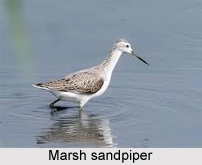 Marsh sandpiper is an Indian bird and it has a scientific name "Tringa stagnatilis" belongs from the small wader.
Marsh sandpiper is an Indian bird and it has a scientific name "Tringa stagnatilis" belongs from the small wader.
Breeding of Marsh Sandpiper
Marsh Sandpiper is a rather small shank, and breeds in open grassy steppe and taiga wetlands from easternmost Europe to central Asia.
Resembles of Marsh Sandpiper
Marsh Sandpiper resembles a small elegant greenshank, with a long fine bill and very long yellowish legs. Marsh Sandpiper is like the greenshank. Marsh Sandpiper is greyish brown in breeding plumage, paler in winter, and has a white wedge up its back that is visible in flight. However, it is more closely related to the common redshank and the wood sandpiper.
Behaviour of Marsh Sandpiper
Marsh Sandpiper together forms a group of smallish shanks which tend to have red or reddish legs, and in breeding plumage are generally a subdued, light brown above with some darker mottling, with a pattern of somewhat diffuse small brownish spots on the breast and neck. The length is 22-26 cm (8.7-10.2 in), wingspan is 55-59 cm (22-23 in) and weight is 45-120 gram.
Migration of Marsh Sandpiper
Marsh Sandpiper is a migratory species. The family of Marsh Sandpiper is majority of birds migrating in winter to African countries, and Indian states with fewer migrating to Southeast Asia and Australia. They prefer to winter on fresh water wetlands such as swamps and lakes and are usually seen singly or in small groups.
Forage in Marsh Sandpiper
Marsh Sandpipers forage by probing in shallow water or on wet mud. They mainly eat insects, and similar small prey. Marsh sandpiper is one of the species to which the Agreement on the Conservation of African-Eurasian Migratory Waterbirds (AEWA) applies.
Concentration of Marsh Sandpipers
Marsh Sandpipers are commonly seen singly, or in small to large flocks in fresh or brackish wetlands of East Indian states such as rivers, water meadows, sewage farms, drains, lagoons and swamps.
Feeding of Marsh Sandpipers
Marsh Sandpiper feeds the aquatic insects, larvae, molluscs and crustaceans species. Marsh Sandpipers feed by wading briskly in shallow water, pecking from the surface or sometimes sweeping the bill from side to side. They may wade deeper and feel for prey.











